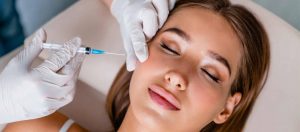 It might not be commonly known, but Botox is actually a brand name that has a surprisingly recent history. Before it was registered as a trademark, it was used medically by an ophthalmologist in the 1970s who was trying to find a treatment for an eye condition known as strabismus, where the eyes point in different directions. So, when did Botox start being used cosmetically? In this article, we’ll cover the timeline from it’s treatment of eye-related disorders to when it became a popular anti-aging and anti-wrinkle procedure.
It might not be commonly known, but Botox is actually a brand name that has a surprisingly recent history. Before it was registered as a trademark, it was used medically by an ophthalmologist in the 1970s who was trying to find a treatment for an eye condition known as strabismus, where the eyes point in different directions. So, when did Botox start being used cosmetically? In this article, we’ll cover the timeline from it’s treatment of eye-related disorders to when it became a popular anti-aging and anti-wrinkle procedure.
Botulinum Toxin
Botox is derived from the botulinum toxin which is created by the bacteria, Clostridium botulinum. The bacteria was first identified in the late 17th century and was found to cause the deadly disease known as botulism. The product that was approved by the FDA for clinical trials to treat strabismus was originally called onabotulinumtoxinA. It’s since been used to treat everything from migraine headaches to excessive sweating.
The Advent Of Botox
In 1991, the scientist who first used onabotulinumtoxinA to treat strabismus sold its rights to the pharmaceutical enterprise, Allergan, which began developing what would eventually be trademarked as Botox. It has since become one of the world’s most popular cosmetic treatment brands and is now approved for use in over 90 different countries around the world.
Botox For Cosmetic Procedures
Botox has become a popular cosmetic procedure because of its non-invasive nature. As opposed to many plastic surgery treatments, Botox is a non-surgical injection that requires very little downtime. It causes temporary muscle paralysis which results in the reduction in the appearance of wrinkles and creases in the skin. Also, Botox injections are not permanent which makes them attractive to people who are apprehensive about permanently altering their appearance. Botox injections generally last for three to four months.
Where Is Botox Most Effective?
As a cosmetic procedure, Botox has been found to be most effective in the upper third of the face. This means it’s often used to relax wrinkles on the forehead, between the eyes and around the edges of the eyes. That said, it can also be used to treat wrinkles on the lower parts of the face such as around the edges of the mouth and the chin, although these types of treatments might not last as long.
 Leeza has been operating a hair removal business since 1987, starting with electrolysis services and then evolving to laser hair removal and laser skin treatments. Being aware of the many different types of laser hair removal technologies available, her method of choosing a successful product was to personally undergo the procedure herself...
Leeza has been operating a hair removal business since 1987, starting with electrolysis services and then evolving to laser hair removal and laser skin treatments. Being aware of the many different types of laser hair removal technologies available, her method of choosing a successful product was to personally undergo the procedure herself...